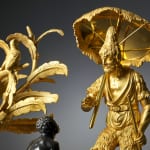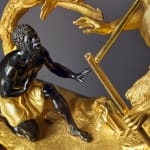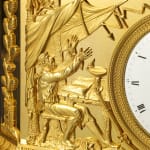Claude Galle (attributed to)
Further images
Literature
High Honour, “The New Golden Land: European Images of America from the Discoveries to the Present Time”, 1975, p. 154, pl. 151, illustrating a very similar clock in the Palazzo Pitti, Florence.
Pierre Kjellberg, “Encyclopédie de la Pendule Française du Moyen Age au XXe Siècle”, 1997, p. 359, pl. F, illustrating another very similar clock sold in Paris, at Mes Ader-Picard-Tajan, 8th June 1990, lot 54.
Elke Niehüser, “Die Französische Bronzeuhr”, 1997, p. 160, colour pl. 261, illustrating a very similar clock in the Musée François Duesberg, Mons, Belgium.
D. and C. Flechon, “La Pendule au Nègre” in “Bulletin de l’Association Nationale des Collectionneurs et Amateurs d’Horlogerie Ancienne”, Spring 1992, no. 63, back cover, illustrating another similar case model. François Duesberg, “Musée François Duesberg. Arts Décoratifs 1775-1825”, 2004, pp. 64 and 65, illustrating two very similar clocks in the Musée François Duesberg.
A very rare and extremely fine Empire gilt and patinated bronze and marble mantel clock of eight day duration, signed on the white enamel dial à Paris. The dial with Roman and Arabic numerals and a fine pair of gilt brass hands for the hours and minutes. The movement with anchor escapement, silk thread suspension, striking on the hour and half hour on a single bell, with outside count wheel. The magnificent case attributed to the esteemed bronzier Claude Galle representing scenes from Daniel Defoe’s celebrated novel Robinson Crusoe, showing at its summit the moment that Robinson Crusoe met Friday, with the bearded figure of Crusoe standing to the right, wearing sandals, a goatskin hat, bolero and matching cut-off trousers and holding a parasol in his right hand and gun in his left, looking down toward the patinated bronze figure of Friday dressed in a native skirt as he kneels beneath a palm tree in which a parrot perches. The two figures and tree on a naturalistic base set upon the clock plinth which is of rectangular shape with angled corners, mounted on the angled corners with cacti growing from a barrel, the clock dial flanked on either side by further scenes from the novel, to the right is Crusoe beneath a palm frond holding an axe and standing at the prow of his ship before it finally sinks while to the left of the dial is Crusoe seated beneath his shelter made from the ship’s sails and tree trunks with him raising his hands to heaven, a bible or another book and cup on his table with his gun propped against it and a lightning bolt above. The whole on a grey veined marble base on bun feet
Paris, date circa 1805
Height 53 cm, width 35 cm, depth 13 cm.
Daniel Defoe’s celebrated novel Robinson Crusoe was first published in 1719, almost a century before the creation of this outstanding clock. The most dramatic episode from the book is recreated at the top of the clock, showing the moment that Crusoe, the son of a lawyer, meets his future companion, who he names Friday since that was the day that the two first met. Crusoe has just rescued Friday from a group of cannibals that had landed on the deserted island, where Crusoe had been ship wrecked and lived on his own for the past twenty eight years. When he first arrived on the island, situated just south of Trinidad near to the mouth of the Orinoco River, Crusoe set about retrieving items from his ship, as shown to the right of the dial. Those items included various weapons, tools and a bible which he read and through which he was converted to faith. With the tools, he made a shelter and cultivated the land. He also kept a few animals and adopted a parrot, named Poll, who here sits in the palm tree above Friday.
The story continues to recount how Crusoe taught Friday the English language and converts him to Christianity. After further cannibals arrive on the island, the two set about rescuing the captives among whom is Friday’s father and a Spaniard who subsequently sets off to find fellow countrymen on the mainland that might provide them with a recue ship. Before it arrives an English ship anchors off shore; however some of its crew had taken charge from the captain. With Crusoe’s help the captain and his more loyal crew members retake command and leaving the worst of the mutineers behind on the island, Crusoe and Friday leave the island and eventually return to England.
Although there is a discrepancy in dates, Defoe’s novel is often considered to be based on the real life story of the Scottish castaway Alexander Selkirk who was marooned on a Pacific island called Más a Tierra, which is now part of Chile and was in 1966 renamed Robinson Crusoe Island. Defoe’s book is often credited as marking the beginning of realistic fiction as a literary theme and thus could be considered the first English novel. From the outset, it was an overnight success; by the end of 1719 it had appeared in four editions and went on to become one of Britain’s most famous novels inspiring later writings, paintings and works of art such as this clock. At the same time, it and other literary works helped inspire the notion of the bon sauvage or noble savage which as part of Enlightenment reflected eighteenth century European society’s fascination with the exotic and, in their eyes, the unadulterated and untamed natural world.
The clock case itself is a tour de force and though very rare, a few other similar models are known. Among them is one in the Palazzo Pitti, Florence while two models, one of the Directoire period and the second of the Empire period, belong to the collections of the Musée François Duesberg at Mons in Belgium. An attribution as to the maker of the sumptuous case is generally accepted by most scholars to be the work of Claude Galle (1759-1815), who with Pierre Phillippe Thomire was the most important bronzier of the Directoire and Empire periods and was renowned for the beauty of his clock cases. As one of the finest gilders and bronze makers of his day, Galle enjoyed the patronage of royalty, the aristocracy and Napoleon Bonaparte. Born at Villepreux near Versailles he was apprenticed in Paris under the fondeur, Pierre Foy. In 1784 Galle married Foy’s daughter and on his father-in-law’s death in 1788 took over his workshop, which he built up into one the finest of its kind. Galle then moved the business to Quai de la Monnaie and from 1805 operated from 60 Rue Vivienne. First listed in the trade registers in 1784 he was received as a maitre-fondeur in 1786 and promptly gained the first of many commissions from the Garde-Meuble de la Couronne. He is known to have collaborated with Pierre-Philippe Thomire, amongst others, and was responsible for the majority of bronzes d’ameublement supplied during the Empire to Château de Fontainebleau as well as Saint-Cloud, the Trianons, Tuileries, Compiègne, Rambouillet and a number of the Italian palaces including Monte Cavallo, Rome and Stupinigi near Turin. After his death Galle’s business was reopened and prospered under his son, Gérard-Jean Galle (1788-1846). Today his work can be found among the world’s finest collections which in addition to the above Imperial palaces includes the Musée National de Château de Malmaison, the Musée Marmottan in Paris, the Museo de Reloges at Jerez de la Frontera, the Residenz Munich and the Victoria and Albert Museum in London.







